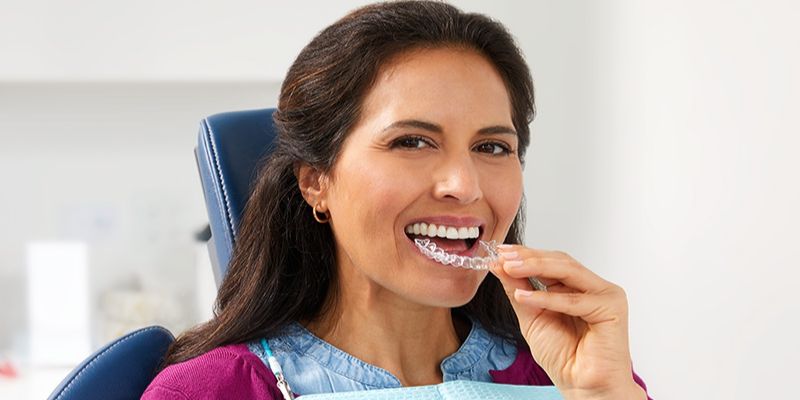Recall the times when practically everyone you knew had braces on their teeth when you were a teenager. It’s not too late if you didn’t wear them when you were younger. Many folks didn’t have braces during their teenage years.
While some young people already have their teeth in perfect alignment and may not recognize the need for braces, others choose to ignore the advice for reasons that are best known to them. To strengthen your teeth and increase your confidence when speaking or smiling, consider wearing braces or clear aligners.
If you have mild or serious malocclusion and want to get braces but would also like to be discreet about the treatment, you can try clear aligners or braces. You should know here about clear braces and aligners and their treatment.
Clear braces versus clear aligners
Both clear braces and clear aligners are discrete options for orthodontic treatment. But they are not similar in every aspect, as some of their differences are quite significant. By comparing clear aligners and clear braces, you can spot individual differences in their pros, cons, and benefits.
The benefits of clear aligners

- They are removable: Clear aligners are removable, which makes it easy for people wearing them to clean their teeth properly. You can remove the aligner trays and brush or floss. Also, you can still have your favorite foods as there are no restrictions.
- They are quick: Clear aligners can accelerate orthodontic treatment faster than traditional braces.
- They are more comfortable: Compared to traditional braces, clear aligners are more comfortable.
- They are more convenient: People who use clear aligners will need to see their orthodontist less frequently to monitor their treatment progress.
Disadvantages of clear aligners
- Unlike other braces, clear aligners only treat mild cases. So, if your malocclusion is complex, your orthodontist will not recommend it.
- Since they are removable, the outcome of treating an orthodontic case with clear aligners will depend on the person wearing them. Therefore, the wearer can neglect the success of the treatment.
In addition, clear aligners do not require the use of wires and brackets to move teeth. Unlike clear braces, they can fix the teeth without wires that tend to loosen over time if the wearer is not careful. Rather, they require less attention and less maintenance or repair. During any emergency visits to your orthodontist, you can get replacements immediately. They are nearly invisible, making wearing clear aligners an adult’s best option.
The benefits of clear braces

- They are more affordable: Clear braces are generally more expensive than typical metal and wire braces, but they are also more affordable than Invisalign.
- Clear braces can treat complex orthodontic cases: Clear braces can easily treat severe dental conditions.
- They are discreet orthodontic options: If you want to correct your crooked smile without getting too much attention from the public, these braces are for you. They are a discrete form of traditional braces.
Disadvantages of clear braces
- Clear braces have dietary restrictions because some of your favorite foods can damage the wires or brackets.
- Because of their large brackets, oral hygiene is difficult when wearing clear braces.
- Some varieties of clear braces can easily attract stains from certain foods, thereby making the braces appear unattractive sometimes.
- It is difficult to remove clear braces after the treatment.
Furthermore, clear braces treat all misalignments. Your orthodontist may recommend this treatment, except if your case is dentofacial and requires surgery. Clear aligners are also known as ceramic braces because their components make them transparent. They are a preferred alternative to metal braces among many adults. Like traditional braces, they use brackets and wires to move the teeth.
Components of clear brackets include the following materials:
- Ceramic
- Porcelain
- Plastic emulator
- Sapphire
- Plastic
- Resin
- Zirconium
Clear braces can fix alignment problems, including underbites, overjets, overbites, crossbites, and open bites. On the other hand, clear aligners can only address non-complicated orthodontic cases.
Where can you get the best orthodontic treatment?
When getting orthodontic treatment, you must first reach out to your orthodontist to have your dental condition diagnosed. Your diagnosis will involve an oral assessment through photos of your mouth and head. They also take an impression and x-ray of your dentures to plan the best treatment.
If your dentist recommends clear braces for your treatment, you will need to wear them for one to three years, depending on your treatment plan. However, after getting your braces, you should visit the orthodontist regularly, or every four to six weeks, for adjustments that allow teeth to move properly.
If your treatment requires clear aligners, your orthodontist will provide several alignment trays. You should wear each set of alignment trays for one to two weeks. According to the American Association of Orthodontists, patients should wear clear aligners for up to 22 hours daily. Remove the aligner before brushing, flossing, or eating, and then replace it.
Your Miami orthodontist can offer you one of the best treatments. When you visit and undergo an oral examination, the length of your treatment will be based on your situation. Therefore, you cannot choose between wearing Invisalign and clear braces. Your orthodontist makes the decision.
Both types of orthodontic treatment are often appropriate for adults, and you can wear them for up to 18 months.
When clear aligners are advised by your Miami orthodontist, the length of the treatment may occasionally change. For 15 months, you must wear up to 30 aligners on both your upper and lower teeth. The aligners can be worn for 12 to 24 months by those with mild conditions, though.
Conclusion
Both clear aligners and clear braces are orthodontic treatments that can boost your confidence. While Invisalign clear aligners are transparent and comfortable to wear, clear braces are discrete like conventional braces. Braces or aligners can be used to treat both severe and minor orthodontic situations, but it is recommended to see your orthodontist to determine the best course of action.


